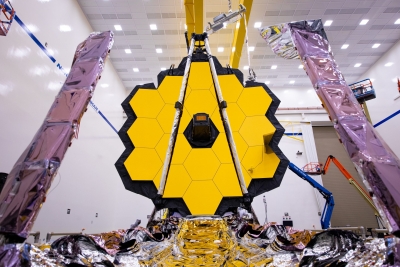
The James Webb Space Telescope is an infrared observatory orbiting the Sun about 1 million miles from Earth to find the first galaxies that formed in the early universe and to see stars forming planetary systems
The James Webb Space Telescope took 30 years and $10 billion to build, has flown over 1.5 million kilometres away from Earth, and now, we can finally see the first glimpse of its power with a collection of images.
NASA has promised the deepest image of our universe that has ever been taken, and these first sets of images are only the first step in a long job of expanding our view of the universe.
When scientists planned and designed the Hubble Space Telescope, the most groundbreaking astronomical observatory of its era, there were many things about the universe they didn’t know. One of these unknowns was that stars and galaxies existed already a few hundred million years after the Big Bang, Mark McCaughrean, senior advisor for science and exploration at the European Space Agency (ESA).
The technology has come a long way since Hubble’s early years, and the James Webb Space Telescope project has been pushing it further along the way.
“The detectors on JWST have 2000 by 2000 pixels. And we have lots of them,” McCaughrean said. “We have many more infrared pixels [on JWST] than Hubble had optical pixels when it was launched.”
So what exactly will all those pixels (in combination with all the other aspects of the mission that make it so ground-breaking) enable James Webb Space Telescope to do?
The James Webb Space Telescope’s giant mirror will feed the light of stars and galaxies into four cutting edge instruments designed not only to take images, but also to analyze the chemical composition of the near and distant universe. This is done with a technique known as spectroscopy, which looks at how matter in the universe absorbs light. As different chemical elements absorb light at different wavelengths, astronomers will be able to reconstruct what stars, nebulas, galaxies and planets within James Webb’s Space Telescope’s sight are made of.
“The James Webb Space Telescope instruments are a factor 10 to 100 [times] better than anything previously available,” Randy Kimble, JWST project scientist for integration, test and commissioning at NASA’s Goddard Space Flight Center in Greenbelt, Maryland, told Space.com. “In some of those mid-infrared wavelengths, there’s probably an advantage of 1,000 for some kinds of observations.”
These improvements in the resolution of infrared imaging are critical for imaging the furthest reaches of the universe. Where the Hubble Space Telescope, or the recently retired infrared telescope Spitzer, could provide only a rough estimate of an ancient galaxy’s age and chemical composition, Webb will deliver with precision, added Kimble, who previously worked on instruments for the Hubble Space Telescope, including the Wide Field Camera 3, Hubble’s most advanced instrument, which was installed during the final servicing mission in 2009.
Credit : Wikipedia
Picture Credit : Google




